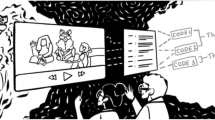Abstract
There are encouraging signs that the history and philosophy of science are becoming more important in the teaching of science and in the preparation of science teachers. This tendency is supported here by looking at the widespread treatment of Galileo's account of pendulum motion in science texts and classrooms, indicating that it is a less than adequate account of the historical facts, and suggesting that the teaching of this commonplace topic can be considerably enhanced if science teachers have some familiarity with basic research in the history and philosophy of science.
Similar content being viewed by others
References
American Association for the Advancement of Science, (1989).Science for all Americans. Washington, AAAS.
ARMSTRONG, H.E. (1903).The teaching of scientific method, London, Macmillan.
ARIOTTI, P. (1968). Galileo on the isochrony of the pendulum.Isis, 59, 414–426.
Association for Science Education. (1963).The training of graduate science teachers. Hatfield, ASE.
Association for Science Education. (1981).Education through science. Hatfield, ASE.
BEDINI, S.A. (1986). Galileo, and scientific instrumentation, in W.A. Wallace ed.Reinterpreting Galileo. Washington, Catholic University Press, 127–154.
BEVILACQUA, F. & KENNEDY, P.J. eds. (1983).Using history of physics in innovatory physics education. Proceedings of an international conference, Pavia, Universita di Pavia.
CARTWRIGHT, N. (1983).How the laws of physics lie. Oxford, Clarendon Press.
CLAGGETT, M. (1959).The science of mechanics in the middle ages. Madison, University of Wiscons in Press.
DRAKE, S. ed., (1957).Discoveries and opinions of Galileo, New York, Doubleday.
DRAKE, S. (1978).Galileo at work. Chicago, University of Chicago Press.
DRAKE, S., and DRABKIN, I.E. eds. (1960).Mechanics in sixteenth-century Italy. Madison, University of Wosconsin Press.
GALILEO, GALILEI (1590).On motion, translated by I. E. Drabkin and S. Drake, Madison, University of Wisconsin Press, 1960.
GALILEO, GALILEI (1638).Dialoque concerning two new sciences, translated by H. Crew and A. de Salvio, New York, Dover Publications.
KOYRE, A. (1968).Metaphysics and measurement. Cambridge MA, Harvard University Press.
MATTHEWS, M.R. (1988). A role for history and philosophy in science teaching.Educational Philosophy, and Theory, 20, 67–81.
MATTHEWS, M.R. (1989). Ernst mach and thought experiments in science education.Research in Science Teaching.
National Curriculum Council. (1988).Science in the national curriculum. London, NCC.
THOMSEN, P.V. ed. (1986).Science education and the history of physics. Proceedings of an international conference. Aarhus Denmark, University of Aarhus.
WOLF, F.A. (1981).Taking the quantum leap. New York, Harper and Row.
Rights and permissions
About this article
Cite this article
Matthews, M.R. Galileo and pendulum motion: A case for history and philosophy in the science classroom. Research in Science Education 19, 187–197 (1989). https://doi.org/10.1007/BF02356858
Issue Date:
DOI: https://doi.org/10.1007/BF02356858




